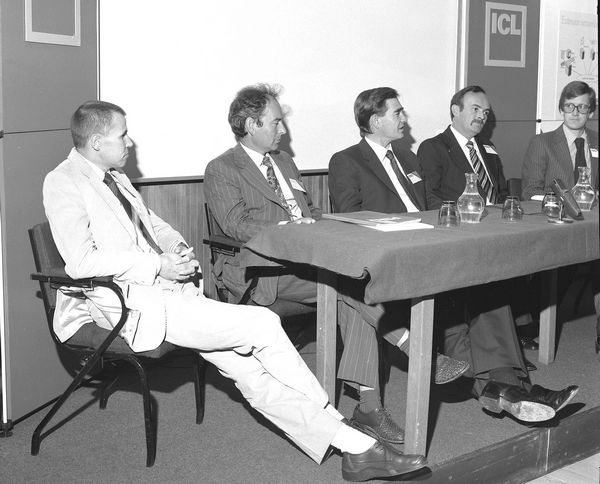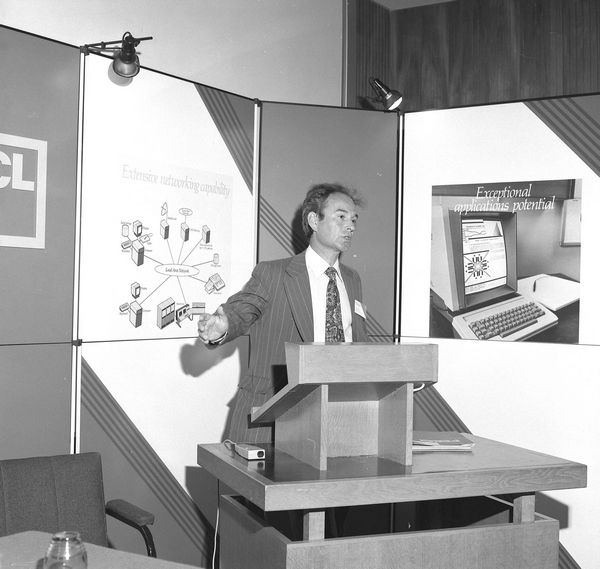

August 1981 arrived with the ICL/Three Rivers contract appearing to be nearly finalised. SERC had full approval from Council to go ahead with a Common Base Policy based on PERQs. Bob Hopgood was due to leave for the USA on 10 August to visit Apollo, Three Rivers and a number of IBM sites in connection with the mainframe replacement. Dr Manning was away on leave from 9 to 21 August. Consequently, it looked as though it would be September before any real announcement of the situation would be made. Prior to leaving, Bob Hopgood contacted ICL who saw no problems in getting the marketing agreement finalised in the next few days. The Memorandum of Agreement between ICL and SERC was almost complete. Some minor modifications were made so that it covered all Research Councils rather than just SERC. Rob Witty agreed to get a first draft of the project specification for the Collaborative Agreement. ICL had not at that time finally agreed that the operating system to be used would be UNIX.
All happened rather quickly thereafter. As many of the dates and times are separated by the Atlantic, the exact sequence of events is difficult to estimate precisely. There was also a discrepancy in USA time zones for some of the negotiations. Frequently, discussions were taking place between people who were separated by a calendar day!
Bob Hopgood flew to the USA on 10 August just as the USA Air Traffic Controllers went on strike. The plane was due to leave for Boston at 11.00. People boarded the plane at 15.10 and sat on the runway at Heathrow until midnight before they could get airborne. It was clear that if they got off the plane, there was no alternative one so people sat it out. The only time Bob Hopgood had seen the film and had two meals before the plane took off.
Halfway across the Atlantic, the plane diverted to New York for repairs. Whereupon British Airways decided not to go on to Boston but go direct to Philadelphia. To avoid the crew being executed by some most irate passengers, it finally took off for Boston landing 5.00 am USA time. The plane journey to Boston took 19 hours.
To add to his problems, Bob Hopgood managed to get a taxi driver who was on his first day at work and he successfully got lost so that he eventually arrived at the Hotel at 6.00 in the morning with a breakfast meeting with Apollo set for 8.00!
Bob Hopgood had breakfast with Bill Poduska and they spent most of the morning discussing Apollo's future products. Apollo had by now realised that the current workstation was no good and were replacing the green phosphor 30Hz display by a 60Hz black and white one in the Spring of 1982. Memory sizes would be increased to 1Mbyte by the middle of 1982 and there was a range of large discs available which were not very applicable to office working. They hoped to bring out a faster processor in 1982 but would probably have to go to a different micro processor. A colour display was scheduled for the end of 1982.
The company were hoping to produce a low cost version (about half the current price) by a complete redesign and getting everything on fewer boards.
They had delivered about 40 systems but were hoping to deliver 10 a week from now on.
Bob Hopgood visited the manufacturing facility where it was clear that a great deal of the work was being subcontracted.
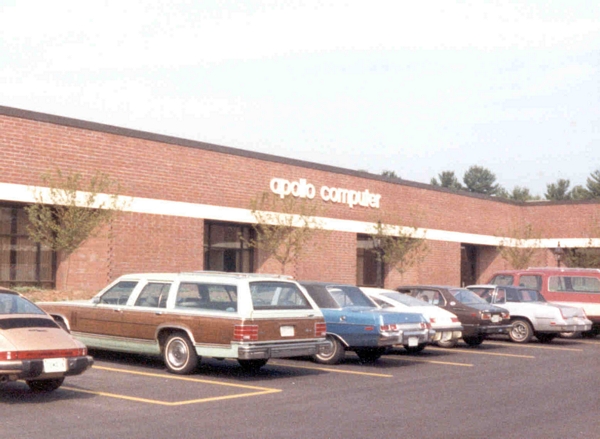
The company had no plans to put UNIX on the machine being convinced that their DOMAIN architecture and operating system was the correct way forward. They did not believe it would be easy to substitute their proprietary ring by a different LAN technology such as Cambridge Ring. The ring interface and disc controller were very closely coupled.
The whole system was still basically keyboard driven. A small touch pad was under development. The general impression was that they still conceived of the Apollo as a mini-PRIME and had not realised the importance of mouse-driven input using a window manager.
Bob Hopgood left Boston a day later after making some other visits convinced that the PERQ was a better product in the short-term and unconvinced that Apollo really understood the market that they were involved in.
Bob Hopgood visited Three Rivers with Dr Thomas of ERCC and Tony Williams, one of RAL's systems programmers, on Thursday 13 August. Three Rivers had by now delivered 100 systems and were producing 6 a week. They hoped to get up to 50 a month by the end of the year. The staff had risen to 100 people.
Nine of the RAL eleven systems were in the dispatch area waiting to be shipped. The system now had a 3-button pointing device in place of the pen on the original bit pad. Unlike Apollo, Three Rivers did a great deal more of the work in house. For example, they had board population and flow soldering equipment while Apollo were dependent on subcontractors. The chassis came as a simple piece whereas Apollo spent hours bolting theirs together out of pieces.
Three Rivers had a room built for environmental testing. Apollo had none.
The hardware developments included a 16K writeable control store option available near the end of the year, ethernet by mid 1982 to replace their existing LAN, 1 Mbyte boards by September, a colour display as an addition to the black and white, paging hardware etc.
On the software side, there appeared to be some dependence on CMU. Three Rivers and CMU had agreed to do a joint development of the SPICE ACCENT operating system with a view to it being available in November. This would replace the current POS operating system.
Three Rivers were negotiating with Human Resources Corporation of Toronto to have UNIX mounted on the PERQ. This was a small software company run by Ron Baecker, a Professor at Toronto University. Bob Hopgood knew him from his graphics background.
FORTRAN was still not available but there were plans to port the UNIX compiler using the CMU C compiler.
Bob Hopgood heard that they had been given two possible contracts from ICL - one was an interim agreement while the other was a much broader based one. They had decided to go with the interim one initially. Wilmot was arriving at Three Rivers in two weeks time on 25 August to sign the deal (this later got moved forward to 20 August, the next week).
Three Rivers seemed to be getting their act together and it was a productive visit.
Tony Williams had visited CMU earlier in the week for technical discussions. The meeting on Friday 14 August concentrated on management aspects and a general overview.
Peter Hibbard was the project director for SPICE with Sam Harbison in charge of most of the systems work. The aim was to provide a personal scientific computing environment for research work, CMU had funds to provide 100 MY's of effort to achieve this. The project had funds of approximately $1.5M per year.
SALT or SPICE81 was seen as the operating system/program environment to be used to develop the final environment. The kernel of this system was ACCENT, a message based inter-process communication facility.
CMU confirmed that the operating system was to be given to Three Rivers with maintenance for the software being a joint responsibility of Three Rivers and the US Navy. A long-term aim was to mount UNIX on top of ACCENT.
Virtual memory was being provided by rewriting the writeable control store code.
CMU had about 30 PERQs and these would be the principle development vehicle for the SPICE system.
It was clear that the close partnership between Three Rivers and CMU effectively increased the Three Rivers development effort by a substantial amount and also added a non-commercial element to the development.
Bob Hopgood spent the Monday to Wednesday of the next week visiting IBM establishments thinking that all was well only to get a phone call from Apollo at IBM on Wednesday 19 August.
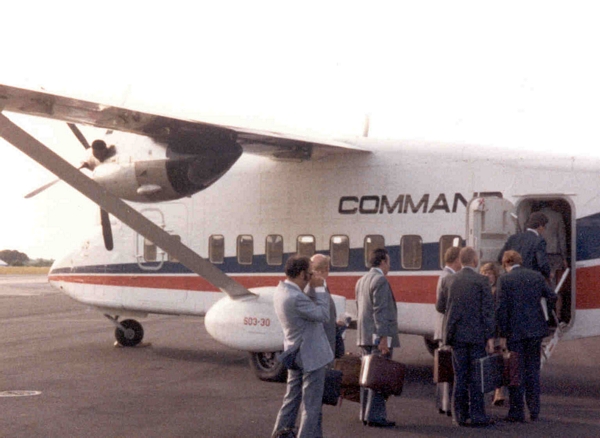
They implied that they were about to make a deal with ICL and would SERC be prepared to switch from Three Rivers to Apollo. Bob Hopgood gave a non-committal answer and phoned Rob Witty to find out what was going on.
Bob Hopgood later found out that Robb Wilmot had paid a courtesy call to Apollo that day on his way to Three Rivers for a meeting the following day. He had been impressed by the company but had made it clear that ICL needed SERC commitment for any agreement reached.
On Thursday 20 August, Wilmot visited Three Rivers. He was clearly unimpressed by the old railway building where Three Rivers were housed and the rather informal management style compared with the professionalism of the Apollo team. Negotiations did not go well. Three Rivers wished ICL to make a $5M up-front payment in order that they could expand to meet demand. At the time, Three Rivers were planning to move into a new factory on the outskirts of Pittsburgh. Three Rivers were also insisting on a royalty on each system sold by ICL. Meanwhile Apollo indicated that they would be prepared to consider all of ICL's terms.
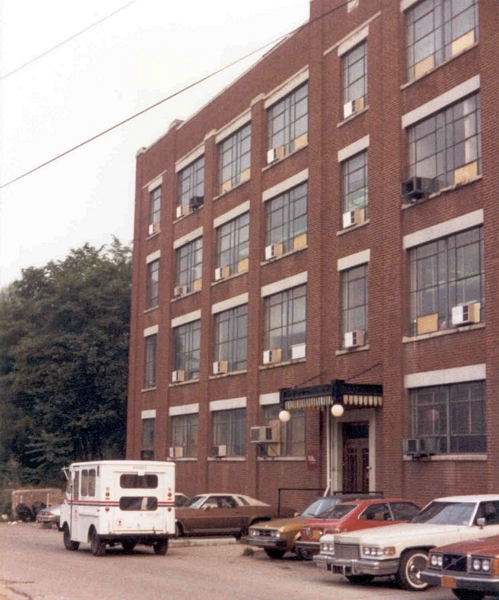
Wilmot returned to the UK that weekend with the intention of considering a switch from Three Rivers to Apollo.
Ninean Eadie visited Dr Manning the next Monday, 24 August, to propose that SERC consider a change to Apollo.
Bob Hopgood had rung Rob Witty the previous evening saying that RAL would not be unhappy with ICL selling both systems but would not wish them to drop the PERQ.
Wilmot phoned Three Rivers and was able to put sufficient pressure on them that they reduced the up-front payment required but still insisted on a reasonable royalty charge.
On Tuesday, 25 August, Nelson and Spectre from Apollo, who had arrived in the UK from the USA, visited both Dr Manning and Robb Wilmot. They argued to SERC that Apollo systems would be better than Three Rivers by the end of the year. They offered ICL exclusive world wide marketing rights for Apollo systems outside USA and Japan.
A meeting between ICL and SERC later that day had Wilmot moving towards Apollo. He was impressed by their plans for a £5K product (compared with Three Rivers reluctance to go solely in that direction). Wilmot was wanting to get the programmable calculator and office automation market.
That day, Bob Hopgood visited Masstor in California and was due to give a lecture at IBM San Jose on Wednesday.
Early Wednesday morning, Bob Hopgood phoned Dr Manning saying that he would fly back as he did not want to see any decision made before having a full discussion. Bob Hopgood cancelled his lecture and drove to San Francisco airport and caught the first plane back composing a summary of the position on the way back.
Meanwhile, Ed Fredkin flew to the UK via Concorde to have further discussions with ICL in an attempt to head off what was turning into a major problem.
Thursday was another round of meetings. By now Wilmot was prepared to switch to Apollo. ICL would receive an attractive royalty on sales. Effectively ICL would be a marketing arm of Apollo. This was similar to other deals being planned by Wilmot where he was strengthening ICL's overall position by offering other people's equipment with an ICL label.
Nelson of Apollo phoned Dr Manning and said that they believed ICL would do a deal with them as long as SERC were also committed. He stressed that Apollo would like to do joint developments with SERC and sent a copy of their future development plans to Dr Manning via Wilmot.
That same day Robin Lingard of DoI had a long meeting with Wilmot which gave him the impression that both Wilmot and Dr Manning were prepared to go with Apollo. DoI was not too sympathetic as they did not see this as a means of increasing the UK's share of the market at all.
A meeting between SERC and ICL was arranged for 28 August, the next day, at 5.30 pm in the afternoon. Wilmot was due to leave for Japan soon after and a decision had to be made by that evening.
Fredkin had a meeting with Wilmot earlier in the day. ICL wanted to get 40 systems early in kit form with boards already tested so that some manufacturing could take place in the UK very quickly. They were still arguing over prices. Wilmot insisted on a more detailed market plan from Three Rivers and, at one stage, left Fredkin with a secretary to compose this while he did other work. Fredkin, jet-lagged, was in no real state to do this.
In the paper he produced, he argued that the strengths of the two companies were quite opposite. Apollo had management strength while Three Rivers had engineering strength. He believed that the market would split about 50: 50 between the microprocessor based products and micro-programmable systems using bit-slice technology. The microprocessor based companies would increase from the 4 or 5 in the market today to 20 or 30 in a year's time. On the other hand, PERQ is the only system on the market which can be tailored to particular application areas.
The graphics capability of the PERQ system was significantly better than any of its competitors and patents had been filed to protect this investment.
He felt that a product such as PERQ would favourably enhance ICL's prestige and help to bring them back into profitability.
The statement contained a great deal of extraneous material which did not help the points made above and ICL were clearly unimpressed.
At the meeting with ICL, SERC presented a Technical Comparison of the two systems which had been put together that day from notes prepared by Rob Witty and Bob Hopgood with technical input from Tony Williams who had just spent time at both Apollo and Three Rivers having technical discussions.
Ninian Eadie gave an overview of ICL's position. They believed that they could do business with either company. A major point was the quality of the two products. Apollo was slightly easier to build but more expensive. They believed Apollo's plans were more solidly based. Apollo were more professional and determined. In their view, SERC's position was critical.
Dr Manning said that in SERC's view, PERQ was currently a better product and more in line with SERC's requirements. SERC had three options:
SERC's position was that it would not drop PERQ because it was what the community wanted.
During the meeting Wilmot oscillated between the conference table, his desk and discussions with his secretary. He was preparing to leave for Japan and gave a good impression of the fast moving tycoon. At one stage, while Rob Witty and Bob Hopgood were extolling the virtues of the PERQ he passed by and said I guess you lot like the PERQ.
The general view of the SERC people when they left the meeting was that ICL had made up their mind to collaborate with Apollo.
RAL still had 11 PERQ systems stuck at Three Rivers waiting shipment and they visited Ed Fredkin at his hotel to see if RAL could change the order to a direct one from SERC to Three Rivers. They had dinner with Fredkin. He had a similar view of the ICL's position and was not his usual expansive self.
At nine o'clock in the evening, Ninian Eadie walked in, was rather surprised to see the SERC people, and offered Ed Fredkin a contract to sign. Fredkin signed and later phoned Three Rivers to release the 11 PERQs. The PERQ Common Base Project was finally going to start.
On 1 September, RAL paid for 50% of the first 11 PERQs to ICL. On 4 September they arrived in the UK. That same day, Robb Wilmot having returned from Japan wrote to Dr Manning thanking him for SERC's input in assisting ICL to make a decision.
On 14 September, ICL launched the PERQ in the UK. The Financial Times, said that ICL's agreement with Three Rivers was a bold attempt by the British Company to rejuvenate its product line by leap-frogging directly into one of the most exciting new fields of computing. It was a commercial arrangement in which, due to its size, ICL would be the dominant partner.
ICL had gained exclusive marketing rights in Europe, Africa, Australasia and other areas throughout the world. The PERQ would be manufactured at Letchworth starting in March 1982. ICL planned to demonstrate PERQ at SICOB in Paris.
The ICL plan was to broaden the software base to include UNIX, FORTRAN and a significant set of software tools to assist designers.
In the press release, Robb Wilmot said that PERQ would significantly strengthen ICL's product portfolio in the scientific and technical computing fields and provide a compact desk-top workstation for universities and a general engineering tool for both public and private research and development establishments.
The press release announced an order of 11 PERQs from SERC. At SICOB, PERQ was a major part in Robb Wilmot's speech concerning ICL' s future framework.
On 23 September 1981, ICL and SERC signed a Memorandum of Understanding with Peter Aylett signing for ICL and Geoff Manning for SERC. The main points of the agreement were:
A further 20 PERQs were ordered by SERC near the end of September.
